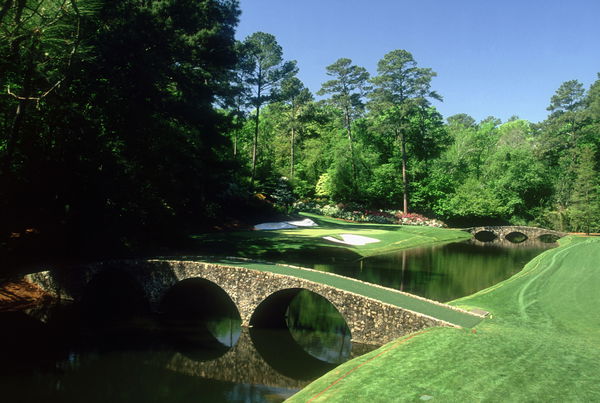
Getty
AUGUSTA, GA – APRIL 07: A flag with the Augusta National logo is seen during the Par 3 Contest prior to the 2010 Masters Tournament at Augusta National Golf Club on April 7, 2010 in Augusta, Georgia. (Photo by David Cannon/Getty Images)

Getty
AUGUSTA, GA – APRIL 07: A flag with the Augusta National logo is seen during the Par 3 Contest prior to the 2010 Masters Tournament at Augusta National Golf Club on April 7, 2010 in Augusta, Georgia. (Photo by David Cannon/Getty Images)
The Masters holds a reputation as the most popular golf tournament on the calendar. A lot of veteran golf fans would agree with the statement as well. There is always so much hype when the Masters tournament is happening, and the event’s venue is equally significant as well.
Watch What’s Trending Now!
So where is the Masters tournament played every year? If you ask any avid golf fan, the answer would come zooming past you within a second. Such is the reverence that the iconic venue holds.
Top Stories
LIV Golf Braces for Another Possible Exit in Wake of Brooks Koepka Departure

Rory McIlroy Makes Feelings Clear on Bryson DeChambeau’s PGA Tour Return: ‘Have Lost…’

Amanda Balionis Confirms New Relationship Ending Months of Rumors

Bryson DeChambeau Gives Reality Check to Phil Mickelson When Asked to Select His Mount Rushmore for Golf

After Brooks Koepka, Another Pro Cuts All Ties With LIV Golf & Publicly Backs PGA Tour

ADVERTISEMENT
Masters tournament: Course details
The Masters is annually hosted at the Augusta National Golf Club. This has remained the tournament’s venue ever since its inception in 1934. The Augusta National is a beautifully designed course that’s been ranked as the ninth-best golf course in the world by golf.com.
The founders and designers of Augusta National
The Augusta National was founded in 1932 by Bobby Jones and Clifford Roberts. As for its design, Jones and Alister MacKenzie carved out the exquisite layout of 18 holes. The Masters is also the only major golf tournament that is held at the same venue every year.
ADVERTISEMENT

Getty
AUGUSTA – APRIL 2000: General view of the 12th hole taken during the 2000 US Masters held in April, 2000 at the Augusta National Golf Club, in Augusta, Georgia, USA. (Photo by Andrew Redington/Getty Images)
Furthermore, here is a fun fact: The Masters wasn’t known by this name until 1939. All tournaments at this venue before the renaming was called the ‘Augusta National Invitational.’
ADVERTISEMENT
Augusta National length and par
The elegant Augusta National course is a par-72 course that stretches 7,475 yards. The layout has been altered considerably in recent years to extend the total distance of the course.
ADVERTISEMENT
Detailed insight about the 18 holes at Augusta National
The Augusta National is a traditional par-72 course, but it poses a lot of challenges through bunkers and water hazards. Moreover, there are particular sections on the course that have become famous for their difficulty level.
There are also three dedicated bridges at Augusta National; The Sarazen Bridge at hole No. 15, the Hogan Bridge at the No. 12 green, and the Nelson Bridge at the No. 13 tee. All of these were constructed in honor of these three players.

Getty
AUGUSTA, GA – APRIL 06: A general view of the 16th green is seen during a practice round prior to the start of the 2015 Masters Tournament at Augusta National Golf Club on April 6, 2015 in Augusta, Georgia. (Photo by Andrew Redington/Getty Images)
Furthermore, each hole is named after a shrub or a plant that adorns it. Here’s a tabulated version containing details about the 18 holes for a better understanding:
ADVERTISEMENT
| Hole | Par | Yards |
| Hole No. 1 (Tea Olive) | 4 | 445 |
| Hole No. 2 (Pink Dogwood) | 5 | 575 |
| Hole No. 3 (Flowering Peach) | 4 | 350 |
| Hole No. 4 (Flowering Crab Apple) | 3 | 240 |
| Hole No. 5 (Magnolia) | 4 | 495 |
| Hole No. 6 (Juniper) | 3 | 180 |
| Hole No. 7 (Pampas) | 4 | 450 |
| Hole No. 8 (Yellow Jasmine) | 5 | 570 |
| Hole No. 9 (Carolina Cherry) | 4 | 460 |
| Hole No. 10 (Camellia) | 4 | 495 |
| Hole No. 11 (White Dogwood) | 4 | 505 |
| Hole No. 12 (Golden Bell) | 3 | 155 |
| Hole No. 13 (Azalea) | 5 | 510 |
| Hole No. 14 (Chinese Fir) | 4 | 440 |
| Hole No. 15 (Firethorn) | 5 | 530 |
| Hole No. 16 (Rebud) | 3 | 170 |
| Hole No. 17 (Nandina) | 4 | 440 |
| Hole No. 18 (Holly) | 4 | 465 |
ADVERTISEMENT
Read Also: Who Is Bryson DeChambeau’s Caddie Tim Tucker?
ADVERTISEMENT
ADVERTISEMENT
ADVERTISEMENT
ADVERTISEMENT

